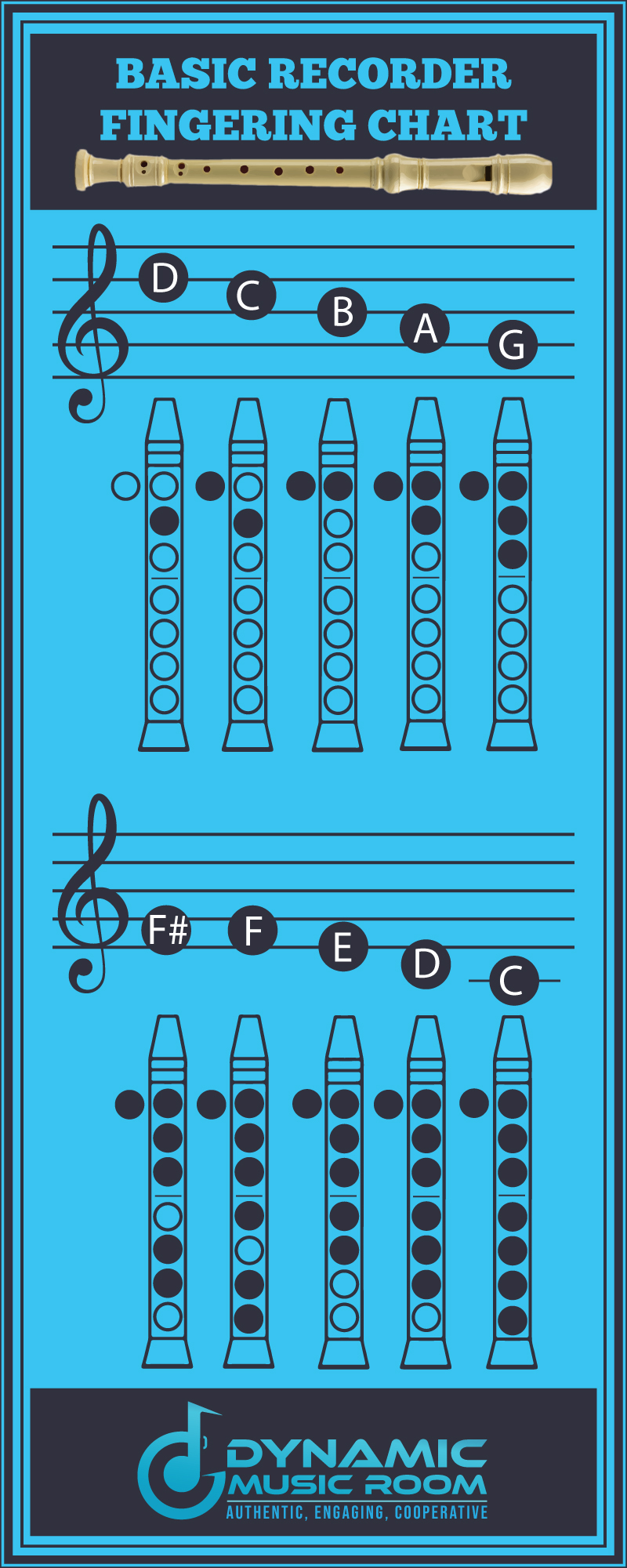Are you looking at how to play the recorder?
Do you want some help understanding the notes of the recorder?
A lot of folks think this instrument is tough, and in some ways, it is. It takes a lot of air control and coordination to make it sound good.
Trust me, though. I’ve been teaching this instrument to kids for over a decade.
It’s not the air that’s tough; it’s the notes.
This is the aspect of recorder that usually holds people back.
Today, I want to go through all the notes on recorder and how to finger them and different things to watch out for as you learn them.

Save time with these 60 FREE Music Resources to use in your room right away!
Stop searching the whole internet to find good activities. I’ll help you cut to the chase with my favorite 60 FREE resources.
Table of Contents
Basic Recorder Fingering Chart
Here is the soprano recorder fingering chart(Baroque-style) I use with my students.
This handy recorder fingering chart covers all the notes you’ll probably use in 99% of your recorder sheet music.
With more advanced notes for recorder, look ahead to sections later on.

Note: I don’t offer a soprano recorder fingering chart(German-style). This is less common and has more issues.
For more information on why check out Baroque vs. German recorder.
Notes On The Recorder Explained
From an air and coordination perspective, this is a great instrument for beginners.
This doesn’t mean it’s always easy; the combination of fingers may be tricky at first, but anyone can play it with practice.
This table will describe how to finger all the most common notes (not including alternate fingerings).
Note: Fingers 1, 2, and 3 are with the left hand, and 4, 5, 6, and 7 are with the right. Left hand on top!
I’ll start with the lowest note and move up.
| Note | Fingering |
| Low C | Thumb, 1, 2, 3, 4, 5, 6, 7 |
| C#/Db | Thumb, 1, 2, 3, 4, 5, 6, half 7 |
| D on recorder | Thumb, 1, 2, 3, 4, 5, 6 |
| D#/Eb | Thumb, 1, 2, 3, 4, 5, half 6 |
| E | Thumb, 1, 2, 3, 4, 5 |
| F on recorder | Thumb, 1, 2, 3, 4, 6, 7 |
| F#/Gb | Thumb, 1, 2, 3, 5, 6 |
| G | Thumb, 1, 2, 3 |
| G#/Ab | Thumb, 1, 2, 4, 5 |
| A | Thumb, 1, 2 |
| A#/Bb | Thumb, 1, 3, 4 |
| B note on recorder | Thumb, 1 |
| High C | Thumb, 2 |
| C#/Db | 1, 2 |
| D | 2 |
| D#/Eb | 2, 3, 4, 5, 6 |
| High E | Half thumb, 1, 2, 3, 4, 5 |
| F | Half thumb, 1, 2, 3, 4, 6 |
| F#/Gb | Half thumb, 1, 2, 3, 5 |
| G | Half thumb, 1, 2, 3 |
| G#/Ab | Half thumb, 1, 2, 4 |
| High A | Half thumb, 1, 2 |
There are other higher notes, but they aren’t used in most common recorder music.
Each link goes to a dedicated article on the recorder note (including advice and songs to play with it).
Check out my massive list of simple songs on the recorder.
Why Is It Always Left-Hand On Top?
Part of its tradition. The left hand is always on top of the recorder.
With the clarinet, saxophone, and flute, the left hand is on top as well.
Learning the recorder with the left-hand makes it easier to transfer that coordination to these instruments.
It’s also designed to actually help right-hand dominant people.
I know this is hard to believe, and I battle this with my younger students all the time.
The right-hand work (the one toward the bottom) will end up being much more active and complicated in the long run.
A good chunk of all the notes just has the left-hand fingers down the whole time.
It’s also how the recorder is designed. If you look at the holes, they’re not all even.
They go in and out of their line depending on the general shape of the fingers. For example, the second hole is farther over than the first and third because the middle finger is typically longer than the rest.
If you play with your right hand on top, your fingers won’t naturally line up with these holes.
The Half-Hole Technique
Starting with high E, you’ll need to use the half-hole technique. This forces the vibration to jump the notes up an octave.
Here’s a quick practice exercise for this technique.
Finger an E on recorder (Thumb, 1, 2, 3, 4, 5). Play this note.
Now, shift your thumb down slightly and increase the focus of your air. It will jump up an octave to play high E.
Shift your thumb back and forth until you can jump from to low to high easily.
Check out this video for how to play high E. The technique applies to most of the higher notes.
Frequently Asked Questions
Here are a few questions we’re often asked about the recorder.
What Is the Range Of The Recorder?
Most intermediate and even advanced recorder players will use the octave and a sixth of the recorder range.
Functionally, it can play two octaves with effort, skill, and practice.
Expert players will also be able to access another fifth above that.
But the inexpensive plastic recorders won’t be able to get those notes.
Which Recorder Has The Highest Pitch?
The garklein or sopranissimo is the type of recorder with the highest pitch.
Its range is from C6 to C8. This is four octaves higher than middle C on the piano.
The frequency is 4,186 Hz. It’s the highest note on the piano as well.
What Are The 5 Types Of Recorder?
There are more than 5 types of recorder, but there are five of the most common ones people see.
These are sopranino, soprano, alto, tenor, and bass.
Learn more about the types of recorder.
Is The Recorder A Serious Instrument?
Yes, it is. There are professional players who study this instrument full-time and make a living playing it.
However, it’s not nearly as common as most other instruments.
In today’s media, the most common use of this instrument is in meme songs.
It’s also featured in the theme of the hit show, The Mandalorian (it’s bass recorder).
Not a serious song, but My Heart Will Go On is a meme song on recorder.
Click the link to check out our guide.
Final Thoughts
I hope this post helps you learn the notes on recorder. Bookmark it and use it as a reference.
Don’t forget to check out our links to dedicated articles and exercises on each recorder note.
Keep on playing!

Save time with these 60 FREE Music Resources to use in your room right away!
Stop searching the whole internet to find good activities. I’ll help you cut to the chase with my favorite 60 FREE resources.

